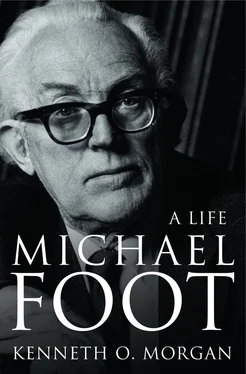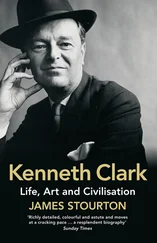Jill Craigie was quite a different proposition from Connie. Part Scots, part Russian, she was two years older than Michael. Although only thirty-four, she had already been married twice, and had a young daughter. Her first marriage had ended before the war, and she was now in an unsatisfactory marriage with a playwright and screenwriter, Jeffrey Dell. Jill was a notable example of how London’s cultural life was galvanized by the experience of war. She went into films, and wrote an ambitious documentary, Out of Chaos , in 1943, inspired by the socialist philosophy of William Morris. She focused on the war artists, and got to know eminent figures like Paul Nash, Graham Sutherland, Stanley Spencer and especially Henry Moore. She also met the writer on urban theory Lewis Mumford during the war, and the influence of his book The City in History inspired her to make a documentary on the rebuilding of a war-damaged city. A title that suggested itself was ‘The Way we Live Now’, and one possible city for the location of the film was Plymouth, where Patrick Abercrombie was to be part-architect of a post-war city plan.
In the autumn of 1944 she met Michael Foot at a party given at his home in Montpellier Row, Twickenham, by the eminent architect Sir Charles Reilly, the father of Foot’s Oxford friend Paul. Foot invited her to dinner at ‘a very posh restaurant’, the Ivy in Covent Garden. Evidently they instantly attracted each other. Foot was captivated by her charm and beauty. She was ‘a raging beauty thrust on susceptible wartime London … She had the colouring of an English rose but everything else was a romantic, mysterious addition.’ 41 He told his mother, who worried about his bachelor status, ‘That’s the girl for me.’ Her attraction for him is very understandable. Apart from her beauty, throughout her life Jill had a sensitive, rapt way of being deeply appealing to men of all ages. No woman listened with more intense attention to the conversation of men, not least Welsh men. But she also had close women friends, including Jenny Stringer in later life. She had in her few years in London attracted the interest, personal as well as intellectual, of an extraordinary group of celebrities: Paul Nash, Henry Moore, Charles Reilly and even the aged Ralph Vaughan-Williams all flirted with her. Another strong admirer was the former Cabinet minister and son of the former Prime Minister, Malcolm MacDonald, who proposed marriage. She looked after his Hampstead house for a time, her neighbour, improbably enough, being General de Gaulle. 42
Jill also attracted Michael with her quick intelligence, her artistic flair, her social poise and (possibly) her vigorous feminism. She herself was immediately smitten by Michael, his honesty, his air of myopic charm. It was love at first sight, even if in Michael’s case it was short sight. The severe eczema which had worried him in his relationships with women was of no consequence to her. She and Michael both had unfinished relationships to unscramble. Jill ended matters with Jeffrey Dell and briefly moved into the Hampstead house of a fellow film-maker, William Macquitty: she was a Hampstead personality years before Michael. Meanwhile Michael had to sort matters out with Connie Ernst.
The relationship between Jill and Michael developed rapidly. His still somewhat undeveloped sexual experience flourished under her confident tutelage. She visited her ‘Mayfair socialist’ several times in 62 Park Street, bought him a new gramophone and encouraged his interests in Mozart and in opera generally. 43 Most important, she told him of her plan to make a documentary on Plymouth, and came down there to work with him on it. Foot himself appeared in the film, looking unusually well-tailored in a smart dark suit. She promised to help in his election campaign. When he went off to America the prospect of her moving into 62 Park Street, cramped though it would be, was a real one.
The partnership of Michael and Jill is a leitmotiv through the rest of this book. It was a marriage of two strong-minded people, each of whom had powerful relationships with the opposite sex, while remaining faithful and trusting. Each gave the other a kind of radiant confidence that lasted for the next fifty-five years. Jill admired Michael’s socialist passion, his literacy, his lack of affectation, his generosity in personal relationships, his humanity. Without changing his personality or his style, she wanted him to succeed. He admired her dedication to work on the feminist movement, while her artistic interests and many friends in the cultural world greatly developed his own somewhat eclectic interests. They did almost everything together: the constituency visits, the trips to Venice or later Dubrovnik, the joint reading of lyric poetry or the prose of Wells or Conrad. Just Plymouth Argyle remained for men only. For Michael, a romantic, passionate man, Jill was the perfect partner.
To what extent her tastes fitted in with his kind of politics is another question. She was not a person with naturally strong political understanding, even though she would respond to great campaigns and was as committed a supporter of nuclear disarmament as Foot himself In old age they crusaded passionately together about the plight of Croatia and Bosnia after the collapse of Yugoslavia, when her expertise in film direction was invaluable. Her advice on political matters, beyond the purely personal, could be unhelpful, and her strong views encouraged Foot’s own fierce and unyielding dogmatism. This trait could be offputting for powerful women of similar outlook, notably Barbara Castle and sometimes Jennie Lee. Barbara Castle’s letters would address Jill, in not altogether friendly fashion, as ‘my feminist friend’. She observed of Jill in her memoirs, ‘Michael used to be as brutal with her as he was with me.’ 44 There were other close political women friends of Michael who found Jill difficult to warm to. She was better liked in Ebbw Vale/Blaenau Gwent, Michael’s constituency from 1960 to 1992, than she ever was in Devonport. Many criticized her after they married for not looking after Michael properly and for allowing him to go to work, even as a minister, scruffily dressed, with shabby suits or cardigans worn out at the elbows. But even in politics Jill could be an invaluable ally, smoothing Beaverbrook’s feathers, rebuilding ties with Bevan after the clash of 1957, nurturing links with the labour movement across the spectrum in the troubles of the early eighties. The Labour Party cherishes its great partnerships – Sidney and Beatrice Webb, Douglas and Margaret Cole, the Callaghans, the Kinnocks, the Blairs. In this pantheon the touchingly loyal team of Michael and Jill may confidently be placed.
Foot came back post-haste to Plymouth at the end of 1944, urged to do so by Jill Craigie, who was waiting in the city for him. He was formally endorsed as candidate at Victory Hall, Keysham, on 8 June 1945. He warmed up with yet more abuse of Hore-Belisha, enquiring as to which party he thought he belonged. In the Herald he derided the term ‘National’ which was being appropriated by the Conservatives, and referred to ‘the sheer native density of the Tory mind’. He ridiculed ‘the antics of the Beaverbrooks and the Baxters, the Brackens and the Belishas – yes, and the Churchills’, lumping together friends and foes new and old. 45 His Herald articles rammed his message home with the aid of old friends from the past – Hazlitt on Peterloo, Paine, Cobbett, the Chartists, the Tolpuddle Martyrs, Keir Hardie, Ben Tillett and Tom Mann, a legendary roll-call of all the saints who for their labours rest. Like other Labour candidates, he raged at the extraordinary campaign being conducted for the Tories by Beaverbrook and Bracken. The first radio election broadcast by Churchill, in which he compared Attlee and his colleagues to some kind of Gestapo, ‘no doubt humanely administered in the first instance’, seemed totally repulsive so soon after newsreels had appeared of the German concentration camps. Attlee won applause in saying that the voice was that of Churchill but the mind was that of Foot’s former patron, Beaverbrook.
Читать дальше












